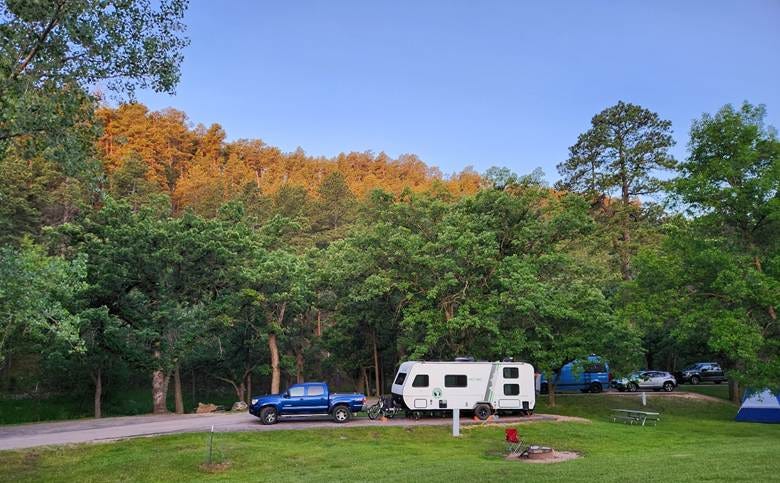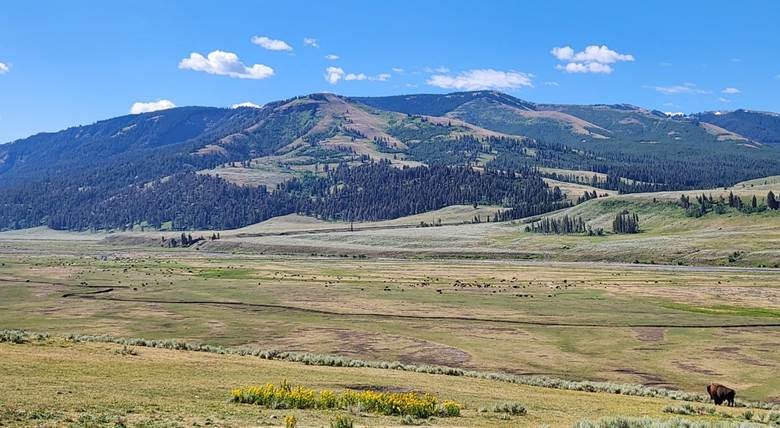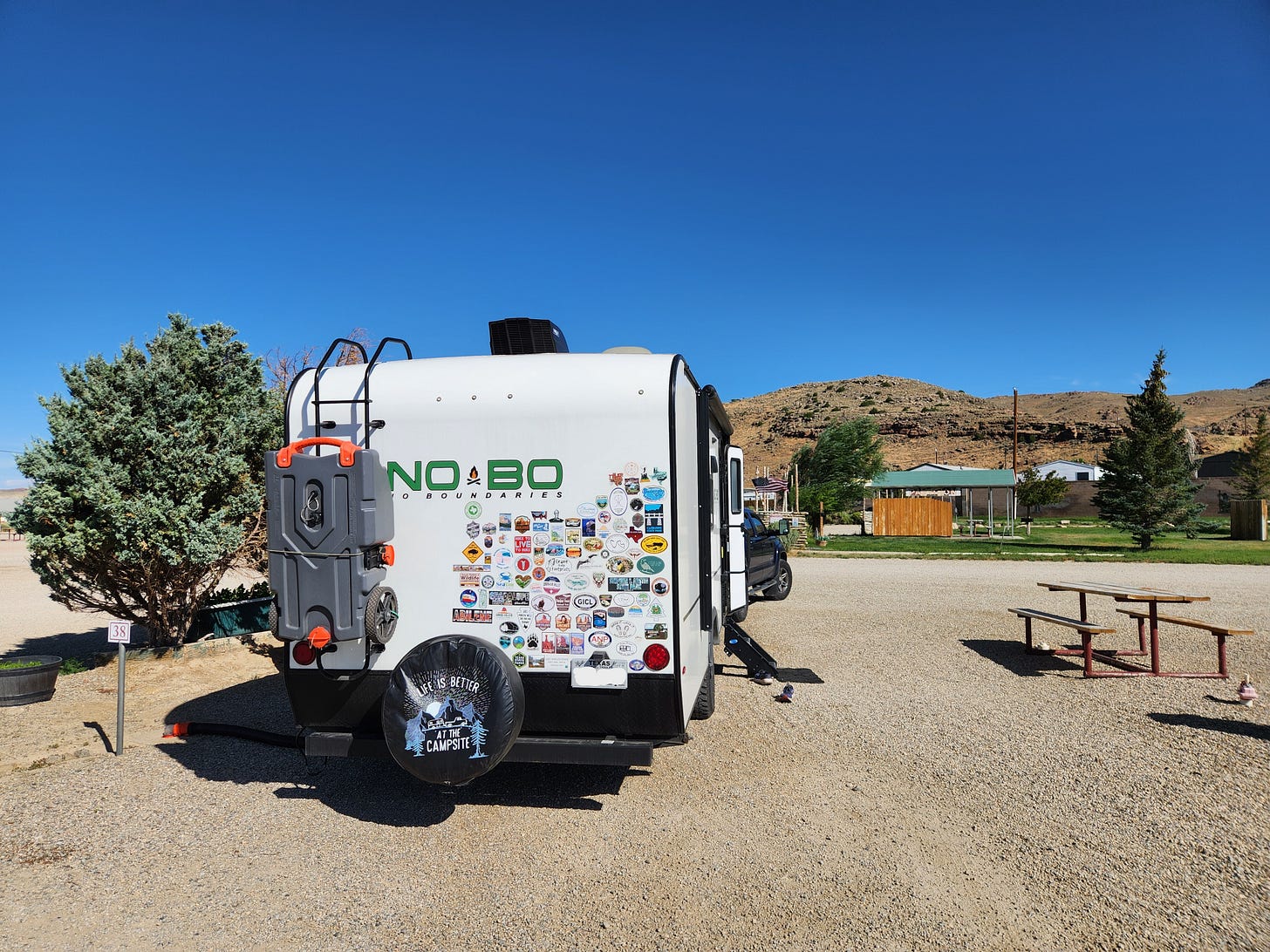
My earliest memory of camping is bouncing in the back of my grandpa’s Chevy Silverado with a 24-foot Aluma-Lite trailer in tow. I was 6 years old, which meant it was the early-1980s, before passenger safety laws for minors. My grandma laid out blankets and pillows in the bed of the truck to cushion the regular bumps along the 3-hour drive to our campground, but they did little to alleviate the painful impacts when my grandpa slammed on the breaks. “Easy on the brakes!” was a common phrase on camping trips. After we pulled in to our site at Ocean Lakes Campground, I helped my grandpa set up the trailer. He showed me how to extend stabilizer jacks on the corners of the camper and install the septic hose, which would be my jobs on future camping trips. After the trailer was level and fully hooked up, my grandparents and I enjoyed a roast beef and swiss sandwich at the picnic table while listening to the waves crash against the beach. This summer camping trip to Myrtle Beach, South Carolina became an annual tradition. My grandparents also took me on camping roadtrips across the Southeast. One trip I remember was to Great Smoky Mountains and Shenandoah national parks when I was about 8. It was my first time experiencing mountains and national parks. I don’t recall many specifics, but one memory that sticks out is eating lunch at a high-elevation roadside picnic table overlooking a broad forested valley. It was probably one of the scenic turnouts along the Blue Ridge Parkway.
Forty years later, I am on a camping roadtrip with my family, very similar to my first ones. We are towing a 20-foot No Boundaries trailer behind my Toyota Tacoma truck. When we arrive at our campsites, my kids extend the stabilizer jacks and connect the utilities if we have full hookups. One difference is that my truck has a cushiony backseat with seatbelts, so Aaralyn and Griffin won’t know the phrase “Easy on the brakes!” We started our roadtrip in San Marcos and traveled north to South Dakota, crossing the panhandles of Texas, Oklahoma, and Nebraska, with Kansas in between. Our first campground was Custer State Park, which felt more like a national park with its natural, cultural, and historical resources. We stayed here four nights and explored the nearby national parks of Badlands and Wind Cave, along with a trip to Mount Rushmore. From there, we navigated north to Cottonwood Creek Campground in Theodore Roosevelt National Park. Our campsite (#53) was shaded by cottonwoods and overlooked the Little Missouri River, which gave us the perfect vantage to view the geologic and wildlife wonders of the park. Victoria said this was her favorite campsite ever.
Our roadtrip continued west to Glacier National Park. It rained everyday here, but we found enough decent weather to hike the breathtaking 6.5-mile in-and-out trail to the Four Falls from Sun Point and drive along the Going-to-the-Sun Road to gaze upon the park’s namesake glaciers before they are all gone in a few years. We then traveled the tremendously scenic byways down to Yellowstone National Park, where we stayed five nights in Grant Village Campground. On the first full day, we visited the various hot springs, pools, geysers, fumaroles, and mud pots. We were fortunate to find the unpredictable Fountain Geyser in full force, with a 50-foot eruption that lasted about 20 minutes. The predictable Old Faithful was even more amazing with an eruption of more than 100 feet, but only lasted a few minutes. We spent the second day exploring Grand Teton National Park. It was too touristy for my liking, but the scenic backdrop of the Teton Range is unmatched. We got there early enough to find a few uncrowded trails and experience the natural splendor of the park. The highlights for the kids were running six miles along Teton Park Trail, followed by a feast at Leek’s Marina. To see the best of the Parks without the crowds, we woke up early every day, usually by 5 am. After a week of this routine, Victoria and the kids were exhausted and begged me for a break. So, we slept in on our third day at Yellowstone and enjoyed leisure time around the campsite, mostly reading and playing board games.

In exchange for a rest day, my family agreed to wake up at 4:30 am the following day so that we could see the sunrise over Yellowstone Lake and beat the crowds to the northeastern focal points of the park. After several emergency stops to watch wildlife, we arrived at Artist Point to behold the grand canyon of the Yellowstone. While nowhere near the grandeur of THE Grand Canyon, Yellowstone’s geologic masterpiece is magnificent for its rugged beauty, hydrothermal color palette, and two dramatic waterfalls. Thomas Moran’s 1872 large landscape painting “Grand Canyon of the Yellowstone” (below) captures this natural wonder. In next week’s post, I will dig deeper into the connections between this pivotal painting and the coincident designation of Yellowstone as our first national park. We continued to explore the (lowercase) grand canyon from various overlooks and a jaunt down to the Brink of Lower Falls, where Aaralyn pondered if someone could survive the 308-foot plunge. Turns out, no one has. After switchbacking back up to the parking lot, we continued our north rim tour with stops at Grand View and Lookout Point, the actual viewpoint of Moran’s 1872 painting.
After a quick bite to eat at Canyon Village, we made the tortuous trip over the Washburn Range to the Lamar Valley, which was my highlight of the three-week national parks tour. Yellowstone’s Lamar Valley is referred to as the “American Serengeti” for its striking scenery, vast meadows along a wide multi-channel river, and abundant wildlife. We were amazed by the 2,000 bison or so, a couple dozen elk, a few pronghorn, two osprey, and maybe a mountain lion (it disappeared into the scrub before the binoculars were in place). The Lamar Valley is also known as the birthplace of wildlife conservation because it was here in the early-1900s where bison were bred and released, saving the species from extinction. In 1995, wolves were reintroduced to the Lamar Valley, which helped control elk numbers and return balance to the ecosystem. The young quaking aspen trees we saw in the valley are evidence of this now healthy ecosystem. Although we spent only one day in Lamar Valley and it will likely be many years before we return, it is gratifying to know that landscapes like this still exist.

Word of the Week

I just returned from our 3-week roadtrip, which is why I haven’t posted anything since July 1st. During this “extended trip in a motor vehicle” (Merriam-Webster, 2025), I thought a lot about previous roadtrips and their broader meaning. While dictionaries spell road trip as two words, I write it as one word to signify an experience. I have taken numerous roadtrips in my life, some solo, a few with friends, many with Victoria, and about three dozen with my family of four. From these experiences, I have learned that the value of a roadtrip is multidimensional. First is the discovery of new landscapes and new knowledge. The freedom and flexibility to explore unique places is an added amenity. We usually use roadtrips to connect with nature and history, particularly in parks (national, state, and city). Fair Park in Childress, Texas was a hidden gem we found, which allows passing-through campers like us to camp one night for free. This change in scenery is complemented by the break from daily routines and stresses. The combined effect is improved mental wellbeing. Emotional wellbeing is also enhanced by the undistracted time spent with loved ones. While we already had a good family dynamic (perhaps strengthened by previous roadtrips), I developed during this roadtrip a better understanding of my kids’ goals and dreams for their future. This will help me be a better dad. Victoria and I had several insightful conversations about our careers as educators and how our roles are changing from teachers to facilitators. I’ll have to cover this paradigm shift in a future post. Lastly and probably most valuable were the shared experiences and lasting memories we made as a family. My memory bank is full at the moment.
Song of the Week
One of the groups we listened to on our roadtrip was The Red Clay Strays. “Wondering Why” was Griffin’s and Victoria’s song of choice, but I am choosing one of their other tracks for the Song of the Week. “Stone’s Throw” has a dual meaning that evokes memories from the last three weeks. The first memory is of me and Griffin skipping stones across Yellowstone Lake. This is something we used to do more when he was younger, so it was a nostalgic moment. The other meaning of a stone’s throw is a short distance. Our roadtrip covered almost 5,000 miles, but with family always around me and our trusty trailer Nobi in tow, home was never more than a stone’s throw away.
We've been gone for way too long
Can't count all the roads we've been down
Oh we're a stone's throw
Oh we're a stone's throw from home











So glad y'all got to see these places! Living in Yellowstone for half a year before coming to San Marcos for grad school was one of my most cherished experiences. There's really nothing else like Yellowstone anywhere. My husband and I worked in the bookstore inside Old Faithful visitor's center, and it cracked me up when people would ask when we turned off Old Faithful every night. Really enjoying your posts!